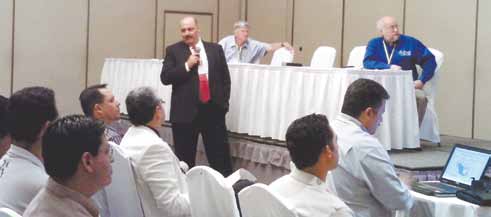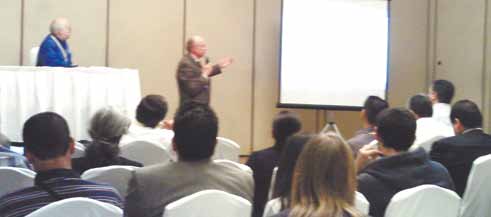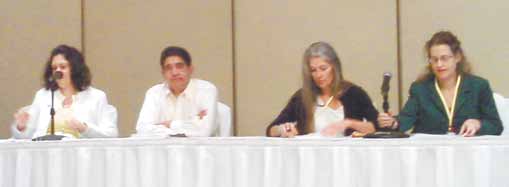 Héctor M. Villegas, from TurboPower Services, talking at a wind energy workshop. (Photos: Elizabeth Frausto Sotelo)
Héctor M. Villegas, from TurboPower Services, talking at a wind energy workshop. (Photos: Elizabeth Frausto Sotelo)
 Fernando Kohrs Aldape, representing the Electricity Research Institute.
Fernando Kohrs Aldape, representing the Electricity Research Institute.
Due to its areas of strong winds, the border between Mexico and the United States is taking shape as a place of intense wind energy development, even without the Mexican side of the border being tapped, this according to the evaluation of experts at the wind energy workshop held during the Border Energy Forum.
With growing demand worldwide, many organizations and companies are directing their energy-generating efforts toward more efficient, economical technology that produces less contamination.
“Let’s be conscious and use green energy”, pronounced Greg Wortham of Texas Wind Energy Clearinghouse, moderator of a panel which included Fernando Kohrs Aldape of the Electricity Research Institute, Héctor M. Villegas of TurboPower Services, Christopher Grant of ReDriven of California, Jorge Landa of the Mexican Association of Wind Energy, and Vaughn Nelson of West Texas A&M University.
All these experts on the topic of renewable energy recognize that wind energy is a clean source of power and that it has already proven successful in wind parks in many parts of the world.
They estimate that by the year 2020, the number of wind parks will triple, which augurs well for a future with wind energy and a hope
 Héctor M. Villegas, from TurboPower Services, talking at a wind energy workshop. (Photos: Elizabeth Frausto Sotelo)
Héctor M. Villegas, from TurboPower Services, talking at a wind energy workshop. (Photos: Elizabeth Frausto Sotelo)
 Fernando Kohrs Aldape, representing the Electricity Research Institute.
Fernando Kohrs Aldape, representing the Electricity Research Institute.
Wind Energy
A Promising Future for Development
of Northwestern Mexico

When human populations were small and technology modest, their impact on the environment was only local, but now large populations and powerful technology are creating significant and widespread problems. Technological advance brought about the discovery, use and exploitation of fossil fuels, the intensive use of mineral resources, the creation of new chemicals, and, most recently, the use of nuclear energy.
Human beings have started changing the face of the planet, the nature of its atmosphere and the quality of its water, according to members of the Coal Solutions Workshop in the Energy Forum.
They also pointed out that the atmosphere is not a barrier to the sun’s short wave radiation, which is absorbed by the earth’s surface.
“Much of this radiation is emitted into space as infrared light, but part is deflected by gases such carbon dioxide, methane, nitrous oxide, the halocarbons and ozone, all present in the atmosphere,” said panelist Johanna Koolemans-Beynen of the Center for Dialogue and Analysis on North America.
These gases raise the global temperature through the greenhouse effect. Due to the burning of fossil fuels these gases have become dangerously abundant. We now see the need to search for solutions to the coal problem, agreed those on the podium, Koolemans-Beyen and business leaders Edward M. Ranger of the American Chamber of Commerce of Mexico and the Climate Action Reserve and Brigid Shea of Carbon Shrinks, Inc.
Two companies are already testing a power plant in the state of Colorado, USA, which could change methods for generating electricity from coal, they said. The hybrid Cameo plant in the city of Grand Junction combines coal and solar energy and shows promise in effectively reducing CO2 emissions, they said.
They granted that coal-fired power plants are widely criticized due to their severe environmental impact and that the new hybrid technology will reduce emissions only a little and at a significant cost.
However, as our resources decrease, the integration of solar energy benefits could mean a major change for this type of plant, the speakers said.
In conventional thermal power from burning fossil fuels, water is boiled to create steam that drives the turbine generator. In this hybrid production, companies Xcel Energy and Abengoa Solar have joined to heat some of the water with parabolic mirrors to concentrate sunlight in the Cameo power plant in the southwestern United States.
With an investment of US$4.5 million, the Colorado Integrated Solar Project has become a pilot program for concept. By reducing coal use in heating water, the plant could lower carbon dioxide emissions and achieve a 3 percent increase in efficiency, according to Marty Smith, director of environmental policy for Xcel.
"We have the opportunity to produce much more solar energy, and save money for the company and customer," says Smith.
The combined coal-solar technology project is the first of its kind in Xcel’s Clean Technology Program, a program which has reduced emissions of greenhouse gases by 26 million tons since 2003.